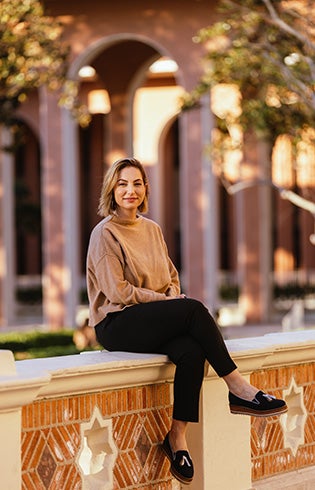
Preserving threatened languages and cultures among top priorities for new Armenian studies institute leader
In the early 20th century, as World War I ravaged much of the world, the Ottoman Empire began systematically persecuting and killing Armenian citizens. The Armenian genocide witnessed the deaths of as many as 1.5 million Armenians, and those who fled to find refuge formed diaspora communities all over the world.
The largest of these diasporas — more than 200,000 people — now calls Los Angeles home. And for the past two decades, the Institute of Armenian Studies at the USC Dornsife College of Letters, Arts and Sciences has been fostering research and collaboration that examines the social, cultural, educational and political issues facing the community.
With L.A. being home to the most Armenians outside of Armenia, there are many first-, second- and third-generation immigrants seeking to establish or maintain ties to their heritage, says Shushan Karapetian, the institute’s new director.
USC Dornsife expert teaches Armenian culture
Southern California lays claim to some of the most vital spaces for the preservation and cultivation of Armenian culture in the diaspora: the event halls of La Cañada Flintridge in the San Gabriel Valley, the comedy clubs of North Hollywood, and the auditoriums of Glendale and Burbank, says Karapetian.

“Humor is very, very important for culture. The children of immigrants may not actively engage with Armenian in any other format, but they love comedy in Armenian,” she explains. “And they can connect with it because it’s a reflection of their bilingual, bicultural lives, from language to religion to dance and food.”
How Armenian culture is transmitted through language — via comedy, literature and other means — is at the heart of Karapetian’s research and is one of the cornerstones of her course “The Armenian Heritage: History, Arts, and Culture” (MDA 330), which looks at how narratives about the Armenian experience are transmitted.
“On the first day of class, I tell students this is not a history course; it is not a genocide course; it is not a culture course or an arts course,” she says. “We look at the defining narratives in the Armenian experience and the ones we make ourselves. The students really enjoy seeing the trajectory of a people across several millennia through this type of interdisciplinary framing.”
Although the course touches on traditional elements of Armenian culture, such as dance, film and literature, and is popular among students with Armenian heritage, it has also resonated with those from other backgrounds, Karapetian says.
“I had a Colombian American student tell me the class helped him come to terms with his own internalized racism and complexes about his hyphenated identity. I had a Black student write a paper on colorism in the Armenian community. That’s the beauty of working at an academic institution in L.A. — there’s such a wealth of diversity here, which allows for cross-cultural impact and transformation,” she says.
“The students really enjoy seeing the trajectory of a people across several millennia.”
Armenian epicenter in L.A.
Karapetian was born in Armenia’s capital — Yerevan, perhaps not coincidentally, is a Los Angeles sister city — during the twilight of the Soviet Union, which included Armenia as a constituent Republic. When she was 10, after the Soviet Union’s collapse, she and her parents moved to California, where she has lived ever since.
Krapetian earned her PhD in Near Eastern languages and cultures from UCLA in 2014 and went on to spend several years there as a faculty member. In 2019, she moved to USC Dornsife to steer the institute’s academic work. Earlier this year, she was appointed institute director.
In 2020, she created the popular podcast series Language Theory with Dr. K, which “looks at language in all kinds of social contexts — immigrant bilingualism, artificial intelligence, religion, music and dance, translation and interpretation, diaspora guilt, and more — with an Armenian twist,” she says.
Language, Karapetian explains, is one of the most important guarantors of cultural transmission that ties diasporic Armenians together and reinforces their links to Armenia itself. She points to an episode of her podcast during which she interviewed comedian Mary Basmadjian — whom she calls “boundary-defying” — about how important humor is to creating and solidifying those ties.
The two discussed the role of comedy not only as a means for holding a mirror to society, but also as a tool for healing. “Comedy does this on two fronts, by providing a safe framing for sensitive subjects along with a linguistic register that is accessible to heritage speakers,” Karapetian says.
“I’ve talked to many kids who didn’t grow up listening to Armenian music, who don’t watch Armenian TV. They don’t engage with Armenian culture anywhere except comedy. They not only love comedy, they actively seek it out. And in comedy, language is the tool. This is why humor, language — these are so important for maintaining Armenian heritage throughout the generations,” she says.
“That’s the beauty of working at an academic institution in L.A. — there’s such a wealth of diversity here.”
As institute director, she plans to continue the podcast and launch other projects to explore facets of language in Southern California’s ever-expanding Armenian community.
“The epicenter of the Armenian diasporic experience is now L.A. It was the Middle East a couple of decades ago. There’s no question that those communities are being emptied, and most of them are redirecting here,” she explains.
The institute, she says, will continue to capture their narratives and experiences through such projects as My Armenian Story, which has sent staff members into local communities via a repurposed food truck to record Armenians’ oral histories. And earlier this year, the institute embarked on a mission to collect testimonies of diasporans for its California History through Armenian Experiences — a project made possible by funding from the State of California and championed by former State Assemblyman Adrin Nazarian.
In addition to having the institute sponsor more research projects on Armenian language and culture, Karapetian also hopes to launch an Armenian language program and an Armenian studies minor at USC Dornsife.
Armenians have been a diasporic people for millennia, she says. But Armenian culture has survived countless dispersions, and the communities have retained their sense of heritage. She cites two high school students, born and raised in L.A., who came to her to discuss using their life savings to start a microloan program in a village in Armenia.
“Why would two American kids who have never been to Armenia spend their entire life savings on this? What are the narratives that drive this kind of activity? This is powerful,” she says.